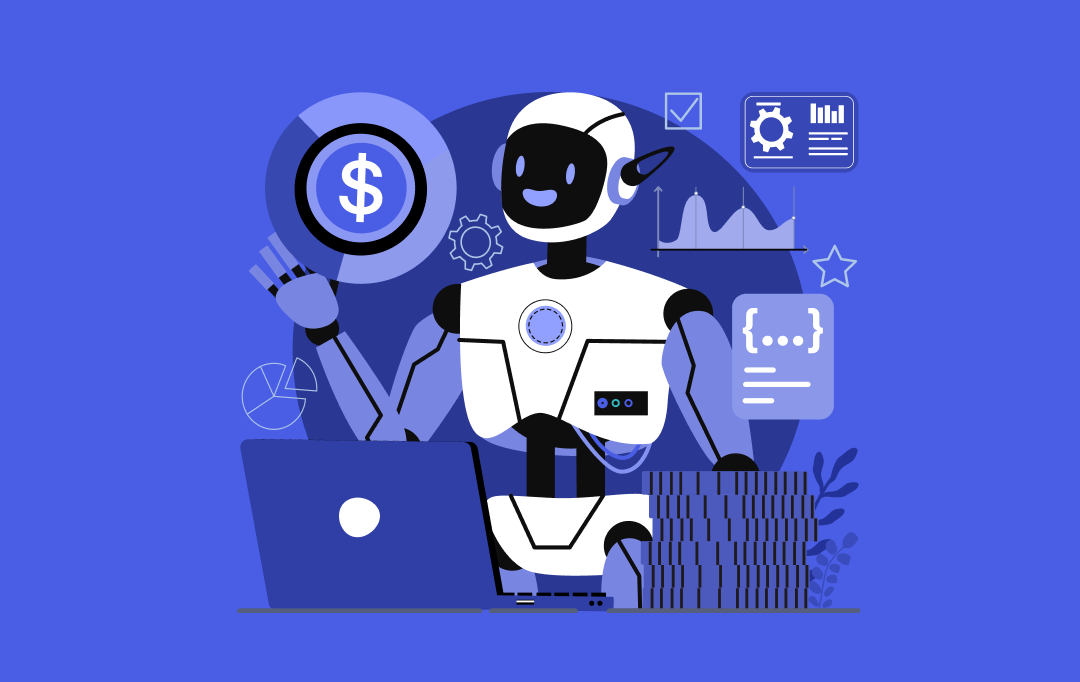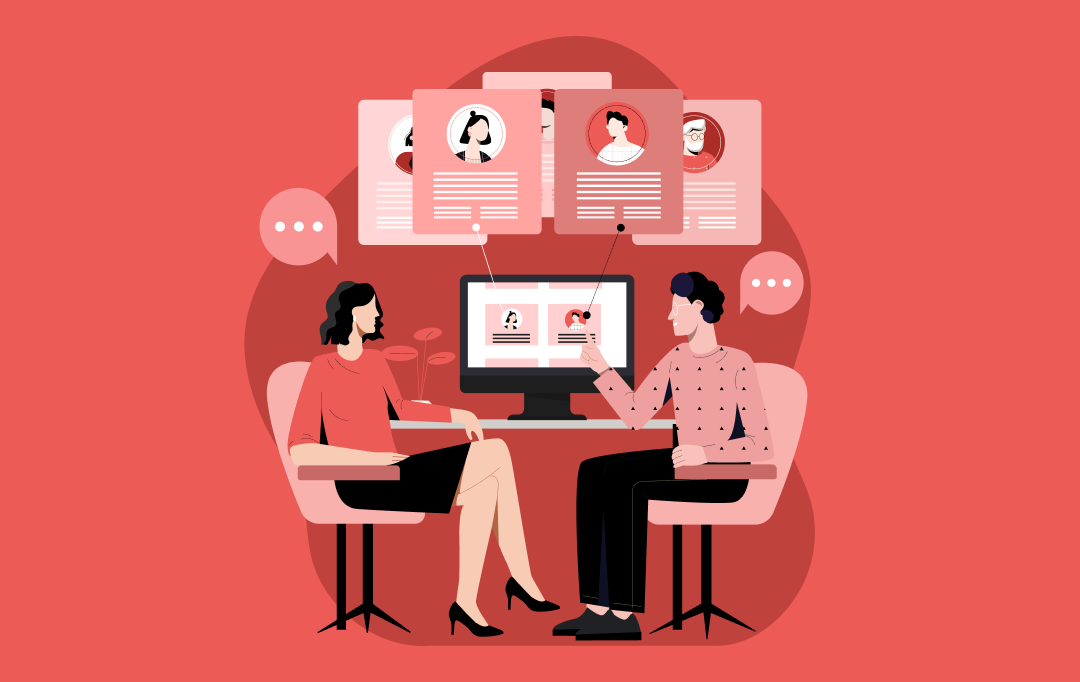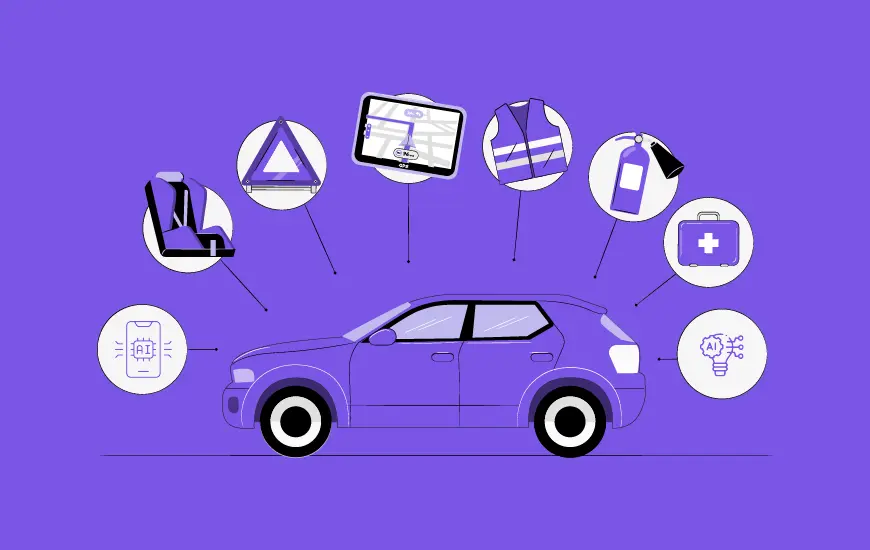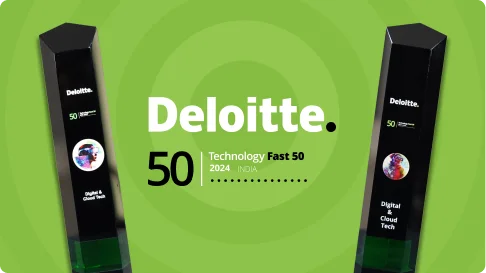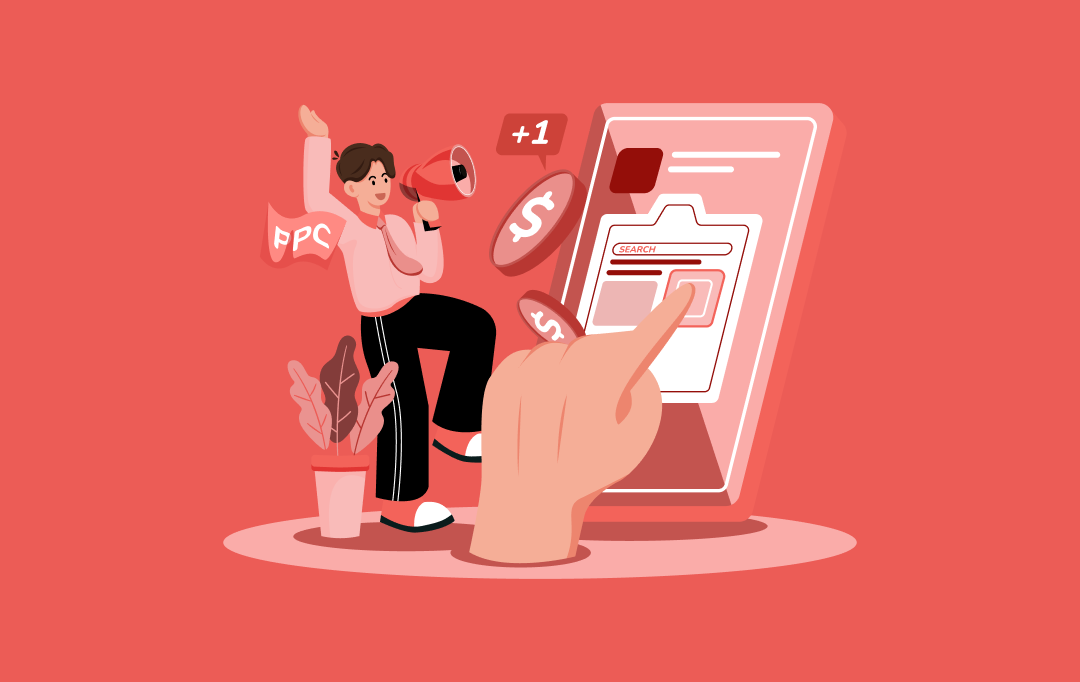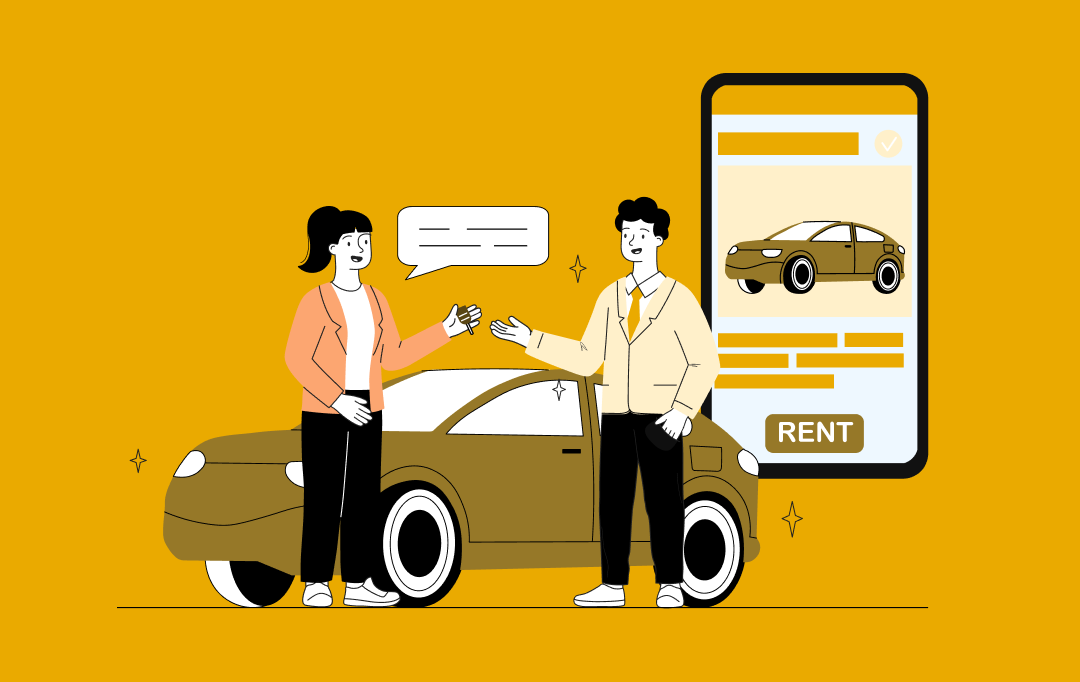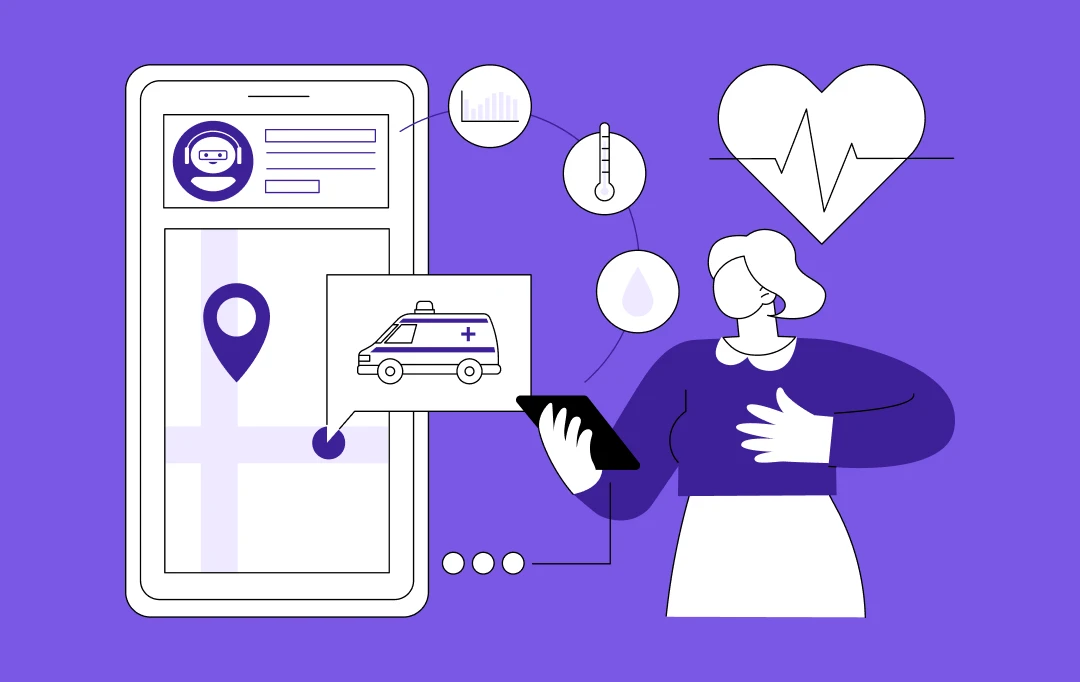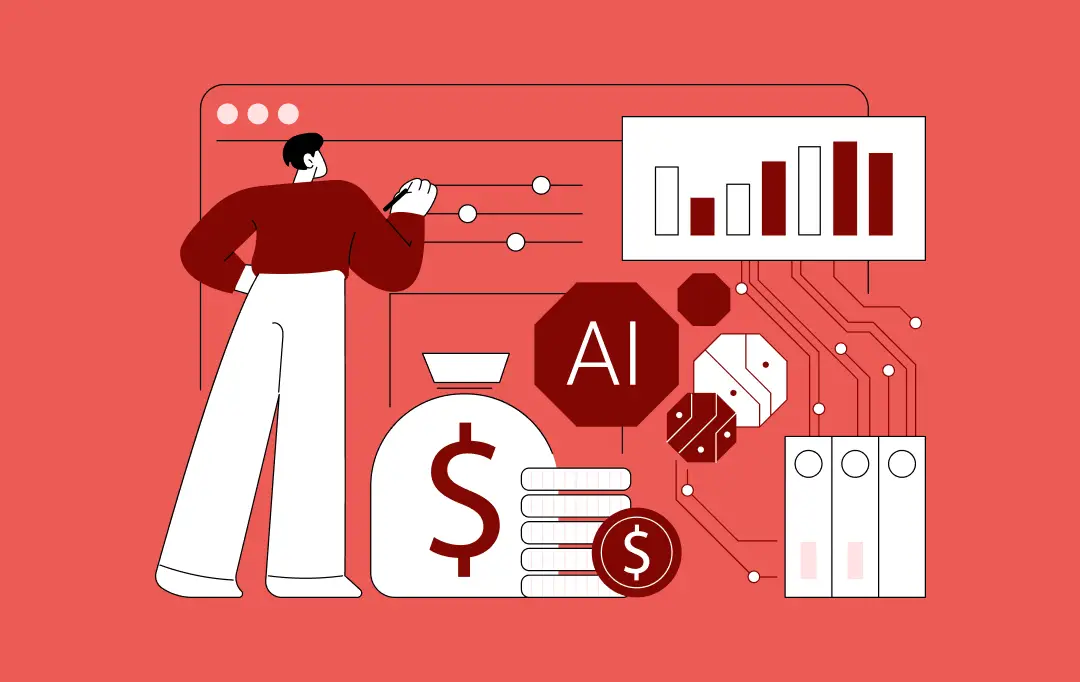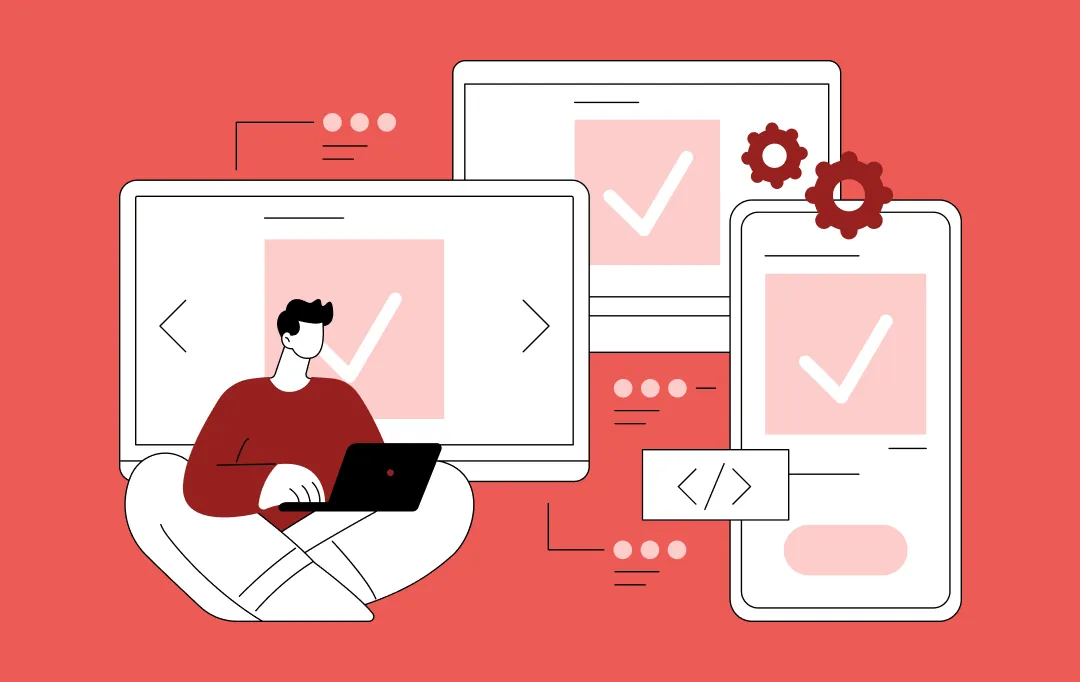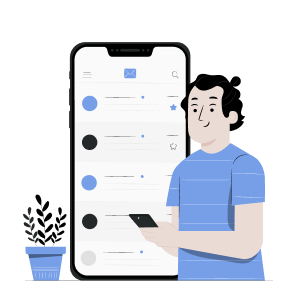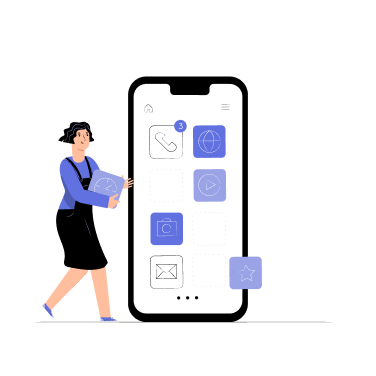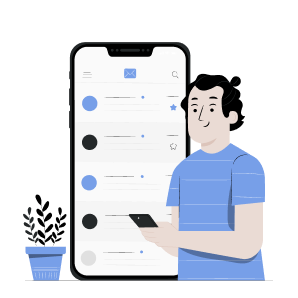- Factors Affecting the App Design Cost
- App Platforms
- App Complexity
- Team Type
- Visual Designs
- Illustrations and Animations
- App Functionality
- User Experience (UX) Strategy
- Integration Capabilities
- Security Features
- Branding and Customization
- Post-Launch Support and Updates
- How Does the App Design Process Impact Costing?
- Discovery phase
- Design phase
- Development phase
- How Much Does It Cost to Design an App: The Final Estimate
- Tips for Reducing the App Design Costs
- Plan Carefully
- Focus on Basic Functionality
- Design for Multiple Devices
- Build for the Future
- Hire a Dedicated Mobile App Design and Development Company
- Benefits of Investing in a Mobile App Design That Stands Out
- Challenges Businesses Face During Mobile App Design Process
- Keeping Up with Technology
- Integration with Existing Systems
- Design Consistency
- Balancing Creativity and Usability
- Budget and Time Constraints
- Future of Mobile App Design: What to Expect?
- Immersive Experiences
- Artificial Intelligence Integration
- Minimalist Design
- Voice-Activated Interfaces
- Enhanced Security Measures
- Sustainable Design
- How to Pick the Right Design Partner?
- Review Their Portfolio
- Check Client Testimonials and References
- Evaluate Their Technical Expertise
- Assess Their Communication Skills
- FAQs
Do you know the first handshake between a business and its customers often happens through a mobile app? Before a user navigates through your features or marvels at your tech-savvy solutions, it’s your app’s design that makes the first impression. This visual representation not only catches the eye but also sets the tone for user experience.
Like the decor of a favorite cafe or the storefront of a chic antique store, your app’s design can draw people in or send them away. That’s why investing in top-notch design is not just a luxury but a strategic necessity.
But how much does it cost to design an app? If you are looking for a straightforward answer, the costs can vary widely, ranging from $3,000 to $30,000. This variation is influenced by factors such as the complexity of the design, the number of app features, the platform, and the experience of the designers you hire. Whether you opt for a sleek, minimalist interface or a dynamic, feature-rich layout, the depth of your app’s design can substantially dictate your project’s budget.
Navigating through these options isn’t just about balancing your checkbook. It’s about understanding what each dollar spent on design brings back in terms of user engagement and satisfaction. In today’s market, an intuitive and aesthetically pleasing app design is not just recommended but rather a norm. Statistics reveal that a staggering percentage of businesses consider investing in good design a top priority because it directly correlates with user retention and satisfaction.
This blog will delve deeper into the cost of designing a mobile app. We will explore the various elements that contribute to design expenses, offer insights from industry experts, and provide real-world examples of cost-effective design strategies. Whether you are a startup on a budget or a well-established brand aiming to revamp your digital presence, this guide will equip you with the knowledge to make informed decisions about investing in your app’s design.
Partner with us to elevate your brand and transform your digital experience!
Factors Affecting the App Design Cost
Several key elements influence the overall cost of app design, each playing a critical role in determining the final price. Understanding these factors can help you better anticipate the investment needed for your app’s design phase.
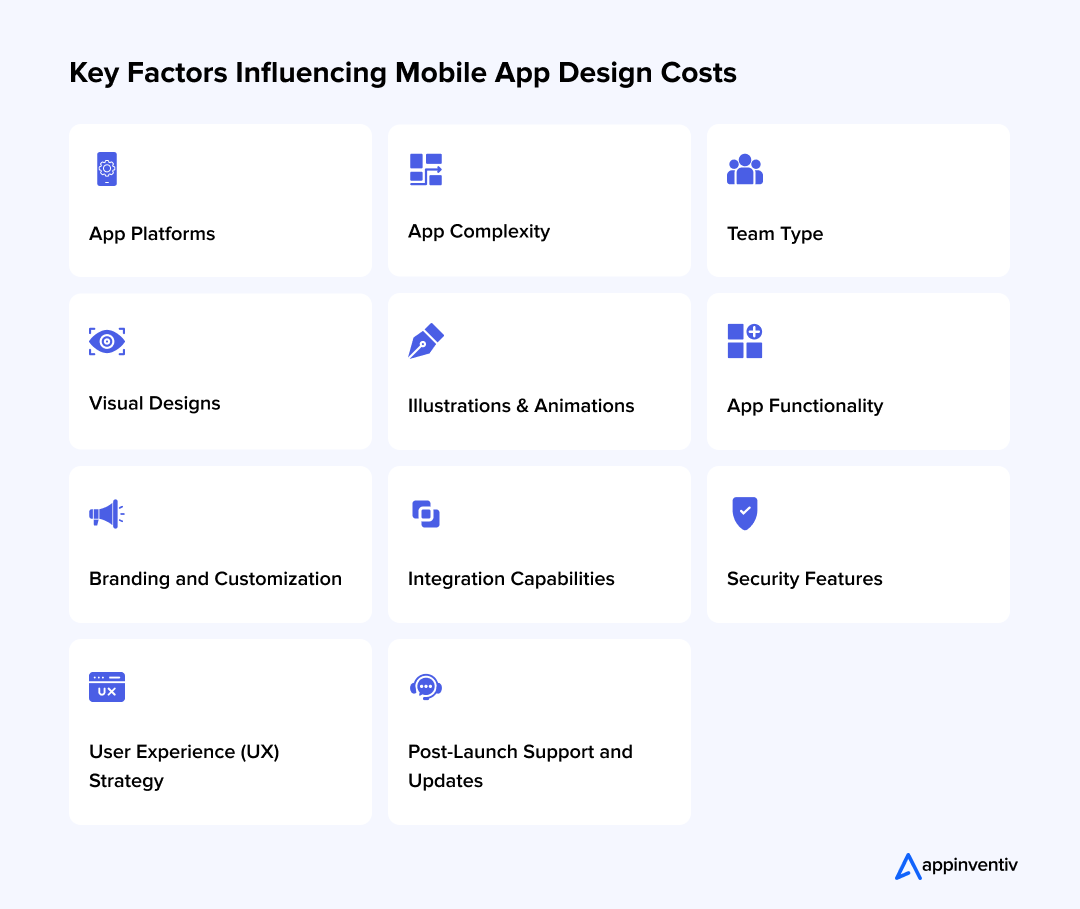
App Platforms
Platforms like Android and iOS differ in how they look and operate. While an Android application has to be matched with different solutions and formats, the same is not the case with iOS for everything to be finalized. This is why Android app design and development is more expensive than iOS mobile app design cost.
Android vs. iOS App Design Cost
Although the mobile app UI design cost might not vary greatly between iOS and Android apps, some differences still exist.
There was a time when the cost of iOS app development was high and UI/UX designers used to charge a lot, but now the situation has changed. Google, too, has come ahead to ensure high quality in terms of what goes into the store, and thus, they have started following a stringent approval process.
So, the comparison between iOS and custom mobile app design costs has come down to the number of platforms and the device types.
Let us look at it from the iOS app design cost perspective first:
iPhone only – The entry models don’t require designers to create images specifically for retina display. So, the approximate cost falls between $3,000 to $10,000.
iPhone 6 Plus and ahead – Designing apps for iPhone 6 and ahead adds 25% to the UI/UX design cost. These devices come with a retina display that calls for high-resolution files and comes with an attached cost.
iPad – iPad app design adds 50% to the mobile app design cost. They require high resolution and product designing solutions to meet the speed and size of the iPads.
Now talking of Android mobile app design:
Android devices undergo continual evolution while adhering to the guidelines of the Google Material Design process for designing. So, to meet the changing needs, Android app designers must continuously adapt to new frameworks and modern mobile app design ideas.
Additionally, the number of platforms a designer has to work on is much greater than on iOS, which automatically increases the Android mobile app design cost.
| Platform | Approximate cost, $/hr |
|---|---|
| iOS | 600 – 1000 |
| Android | 650 – 1200 |
App Complexity
So, considering the app’s complexity, how much does it cost to design an app? Well, three complexity levels are considered to evaluate the cost variables, whether we talk about UI/UX design cost, modern mobile app design ideas, mobile app development cost, or app maintenance cost.
Basic Apps
These applications are maximum of 3 screens long and use zero animations and interactive design elements. Apps like calculators and alarms fall under this category.
Average complexity apps
These apps are the ones that make use of multiple interactive features and animations along with several screens. They are usually designed individually for Android and iOS platforms and are made to meet the native look and feel of the platform. They rely on human interface design guidelines and Google Material design principles.
Most of the apps you use every day, like WhatsApp and Uber, are examples of what a medium complexity app looks like.
High Complexity Apps
These applications depend on mobile app designs to serve their purpose. Here, a lot of animations and transitions are used to help users move from one screen to another and ultimately convert them into regular users. The OTT apps like Netflix, Amazon Prime, and more are examples of complex apps.
These apps use many screens and usually work on multiple screens – all demanding a device-centric native UI design.
| Complexity | Approximate cost, $/hr |
|---|---|
| Simple app design | 40 – 60 |
| Average app design | 150 – 350 |
| Complex app design | 400 – 1000 |
Team Type
The price depends on the kind of team selected to design an app. An in-house team of designers will typically be the most expensive option, while outsourcing a team or hiring freelancers may be more affordable. Several factors determine whether to hire freelancers. Check out our blog on in-house team vs outsourced experts to make the right choice per your business requirements.
| Team type | Approximate cost, $/hr |
|---|---|
| In-house | 35,000 |
| Outsourced | 12,000 |
| Freelancer | 6,000 |
Visual Designs
From colors to final UI mockups, how you decide to represent your app visually can impact the overall cost. One of the most important visual elements in any mobile app is color. The right colors can help set the tone and feel of the app and can also be used to highlight key features.
However, using too many colors can increase the cost of app design, as it will require more work to balance and harmonize the colors throughout the design. If you’re on a budget, stick to a limited palette of 2-3 colors.
Few other important visual elements include typography, moodboards, UI mock-up samples, and final UI mockups. The typography includes the font you choose for the app that plays a vital role in conveying its personality and tone.
Moodboards help to set the tone and feel of an app, they can be a great way to communicate your vision to the team. UI mockup samples can help determine an app’s overall layout and flow. Finally, final UI mockups are important for ensuring that the design of an app looks polished and professional.
Illustrations and Animations
Animations and illustrations include any graphic element that is not a photo. This category includes icons, logos, vectors, gifs, and more. Icons and logos are particularly important in branding and can help make your app more recognizable. Animations can be used to add personality or interactivity to an app, but they can also increase the cost of app design, as they require more time and effort.
App Functionality
When it comes to the functionality of an app, there are two main factors that will affect the cost of app design: features and complexity. The more features like in-app purchases and social media integration your app has, the more expensive it will be to design. If you’re on a budget, stick to including only the essential features like user login, search, and sorting.
User Experience (UX) Strategy
Creating a thorough UX strategy involves researching user needs and behaviors, which directly influences design decisions. A comprehensive UX strategy ensures the app is not only visually appealing but also user-friendly, increasing the engagement and retention rates. This phase might involve additional costs for user testing and iteration based on feedback.
User experience design is crucial for streaming platforms, and designing sports streaming apps like Kayo Sports requires specialized knowledge of sports content presentation and live viewing interfaces.
Integration Capabilities
The ability to integrate with existing systems like social media, ERP systems, or cloud services can increase design complexity, as interfaces for these integrations need to be user-friendly and align with the overall design. This requires additional planning and testing, which can drive up costs.
Security Features
For apps that handle sensitive data, incorporating advanced security features is crucial. Designing secure interfaces that ensure user data protection, such as encryption and secure data input forms, requires expertise in cybersecurity, which can increase the cost.
Branding and Customization
The extent to which app design needs to align with existing branding can affect costs. Custom designs that reflect a brand’s identity require more detailed work and unique elements like custom icons, which can increase costs.
Post-Launch Support and Updates
Ongoing support and updates are essential for keeping the app relevant and functioning optimally. Design adjustments and updates post-launch based on user feedback and evolving trends can significantly add to overall costs.
Now that we’ve looked into how much does it cost to design an app and the common factors that affect mobile app design cost, let’s take a look at how the design process impacts the overall budget.
How Does the App Design Process Impact Costing?
The app design process significantly impacts the overall cost of mobile applications. Businesses can better manage their budget and ensure efficient resource allocation by understanding each phase, such as discovery, design, and development. This structured approach streamlines the workflow and helps pinpoint where costs can be optimized without compromising quality.
Discovery phase
The discovery phase is about understanding the problem you are trying to solve. This phase includes market research, user persona, user journey mapping, and competitor analysis.
Market research
In-depth market research can help to identify target users, understand their needs and determine what they are willing to pay for an app. This information can then be used to perform the app design process, ensuring that the final product is tailored to the needs of the target market.
Also, market research can help identify any potential competition, allowing businesses to ensure that their product is differentiated and able to compete in the marketplace.
User persona
User personas can impact the design process in a number of ways. For example, they can help you understand what features are most important to your users and how they will use those features. This information can be used to make informed decisions about functionality, layout, and usability.
Personas can also help identify potential issues that may arise during app usage. For example, if a user is a busy working mother, she may have difficulty using an app if it requires her to enter a lot of data. By taking into account user personas, you can design an app that is more user-friendly and less likely to cause problems. Ultimately, this can save you time and money in the long run.
User journey mapping
It is a process of creating a visual representation of how users interact with a product or a service. When used correctly, user journey mapping can have a significant impact on pricing. By understanding how users interact with an app, designers can identify areas where improvements can be made for a seamless user experience.
This, in turn, can lead to reduced development costs and a more efficient app design process. In addition, user journey mapping can help identify potential areas of customer churn, which can again lead to cost savings. As such, user journey mapping is a powerful tool that should be considered when planning the design of any app.
Competitor analysis
By taking the time to examine competitors’ apps, businesses can get a better understanding of what works and what doesn’t for their users. This information can then be used to make your app more user-friendly and successful. In addition, competitor analysis can also help businesses identify any market gaps that you can take advantage of.
Design phase
The UX design phase is all about creating the user interface and user experience. This phase includes sketches, wireframes, prototypes, and user testing.
Sketches
These are the first and integral step in the design phase as it helps understand how users will interact with the app. Sketches help save time and money by allowing businesses to test different customized mobile app design ideas without quickly creating a fully-fledged prototype.
Wireframes
After the sketches are complete, it’s time to start creating wireframes. Wireframes are a more detailed version of the sketches and represent the placement of all the elements on each screen. This is a critical step in the design process as it helps ensure that all the elements are placed effectively and efficiently.
Not only does wireframing help identify potential problems early on in the design process, but it can also be used to explore different solutions and test out modern mobile app design ideas.
Prototypes
Once the wireframes are complete; it’s time to start creating prototypes. Prototyping is the process of creating a mockup of the app. By creating a working prototype of an app, businesses can get a much better sense of how an app will actually work. This not only saves time and effort in the designing process but also helps ensure that the final product is closer to the original version.
User testing
User testing is a process of seeking feedback from potential users to improve the app’s usability. By observing how users interact with the app, businesses can identify areas where the user experience can be improved. In addition, user testing can help uncover hidden problems that may not be apparent during the design process and in turn, can save a huge amount of time and money.
Development phase
The development phase focuses on bringing the app’s design to life through coding, followed by testing for functionality and user feedback.
Coding
Coding is a crucial step in the app development process, enabling the app to function and produce the desired outcomes. Without coding, an app remains a collection of static images.
Coding facilitates the connection to external data sources, including databases and web services, enhancing the app’s capabilities and user experience.
Testing
Testing provides a valuable opportunity to explore how users interact with the app and identify potential areas for improvement. In addition, testing can help identify any bugs or glitches that may need to be fixed before the app is released. By taking time to test the app thoroughly, businesses can ensure that users will have a positive experience with it and be more likely to use it regularly.
Launch
By carefully planning and testing the launch process, businesses can ensure that their app will be successful in the marketplace. In addition, the launch can also help identify any bugs or glitches that need to be fixed before the app is made available to the general public. This can increase the chances of the app being downloaded and used by customers.
Appinventiv, as a leading provider of custom mobile app development services, works on the prototypes collectively. Developers, Business Analysts, and Clients work together to create an application that everyone can agree on. This, in turn, helps in identifying issues and confusions priorly that could occur at the development stage.
Deliverables: App screen wireframe, interactive prototypes
[Also Read: Know more about how to get angel funding on your mobile app prototype?]
How Much Does It Cost to Design an App: The Final Estimate
In general, the cost of designing an app ranges from $3,000 to $30,000. The final cost depends on a number of factors, including the complexity of the app, the number of features, and the number of devices it needs to work on. However, there are several ways to reduce the mobile app UI design cost.
Efficient project management and careful selection of design features are key to optimizing costs without compromising the app’s quality. Prioritizing essential features, choosing the right design team, and leveraging pre-built components can help manage expenses effectively while achieving desired outcomes.
By following the tips listed below, you can keep your costs down and ensure your app succeeds.
Tips for Reducing the App Design Costs
To reduce the cost of designing your mobile app, it’s important to approach the process strategically and thoughtfully. Efficient planning and clear prioritization of features can significantly lower expenses while still achieving a high-quality design that meets your business needs.
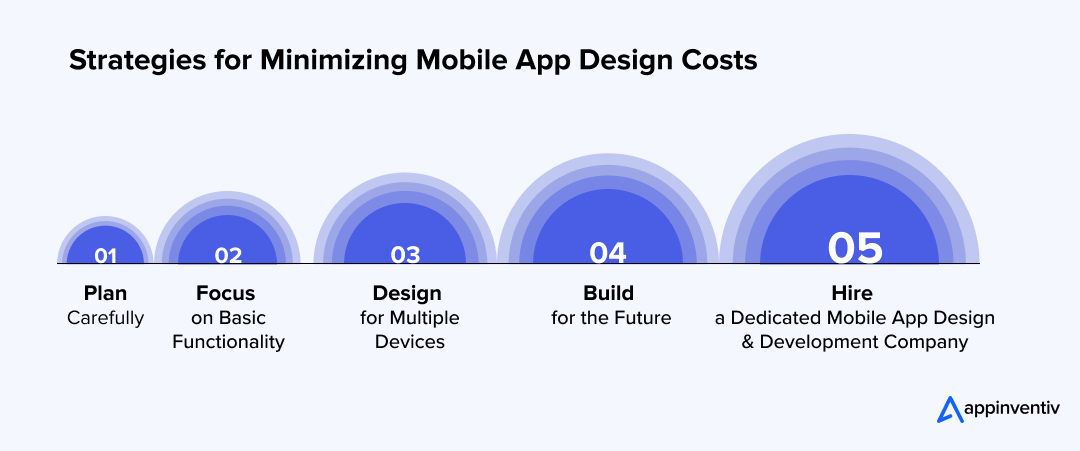
Plan Carefully
Careful planning is essential when it comes to customized and best mobile app design. You’ll need to take some time to map out various app features and functionality. This will help determine which elements are crucial and which can be omitted. Having a clear plan from the start will help you avoid costly changes and revisions down the road.
Focus on Basic Functionality
When designing your app, it’s important to focus on the basic functionality. First designing a prototype can be helpful. Resist the temptation to add too many features, stick to the basics, and you’ll be able to keep your costs down.
Design for Multiple Devices
When designing your app, it’s important to remember that it will need to work on various devices. This includes smartphones, tablets, and even desktops. By designing for various devices from the start, you can avoid the need for costly redesigns later on.
Build for the Future
When designing your app, it’s essential to think about the future. This includes developing for new devices and operating systems as they are released. By building for the future, you can avoid the need for costly updates down the road.
Hire a Dedicated Mobile App Design and Development Company
If you are looking for the answer to how much does it cost to design an app and also want some of the major tips to optimize the costs, hiring a dedicated UI/UX design company can be the right choice. These companies specialize in designing cost-effective solutions that meet your specific needs.
Benefits of Investing in a Mobile App Design That Stands Out
Investing in a standout mobile app design is about aesthetics and creating a functional, user-friendly interface that enhances the user experience and supports business objectives. A well-designed app can significantly impact customer satisfaction, retention, and brand perception.
Here are a few reasons businesses should invest in a mobile app design that stands out. It can help reduce the cost of designing an app associated with customer support, marketing, and user acquisition by improving efficiency and fostering customer loyalty.
| Benefits of Mobile App Design That Stands Out | Implementation Details | How It Helps Businesses |
|---|---|---|
| Improved User Engagement | Integrates interactive elements and intuitive design to captivate user attention. | Increases time spent in the app, potentially leading to higher conversion rates. |
| Enhanced User Experience | Simplifies navigation and streamlines user interactions for ease of use. | Reduces user frustration and abandonment, increasing customer satisfaction. |
| Increased Brand Recognition | Incorporates unique design elements that are synonymous with the brand’s identity. | Helps the app and, thus, the brand to stand out in a crowded market. |
| Competitive Advantage | It includes superior features and design quality not commonly found in competitor apps. | Attracts more users due to superior functionality and aesthetics. |
| Higher Retention Rates | Designs a visually appealing and rewarding user interface. | Retained users are more likely to become loyal customers and brand advocates. |
| Accessibility Improvements | Complies with accessibility standards to accommodate all users. | Expands market reach and inclusivity, enhancing the brand’s reputation. |
| Streamlined Operations | Enhances app workflows, such as data input and retrieval processes. | Reduces operational costs and increases efficiency in customer interactions. |
| Data-Driven Insights | Leverages user interaction data to support informed business decision-making. | Provides valuable insights into user behavior, aiding in targeted marketing. |
After looking into how much does it cost to design an app, the various tips to reduce the overall app design costs, and the benefits of investing in a stand-out design, let’s move ahead and help you understand multiple mobile app design challenges businesses usually face.
Challenges Businesses Face During Mobile App Design Process
During the mobile app design process, businesses face several challenges that can directly or indirectly impact the overall cost of app design. Let’s explore these challenges in detail below.
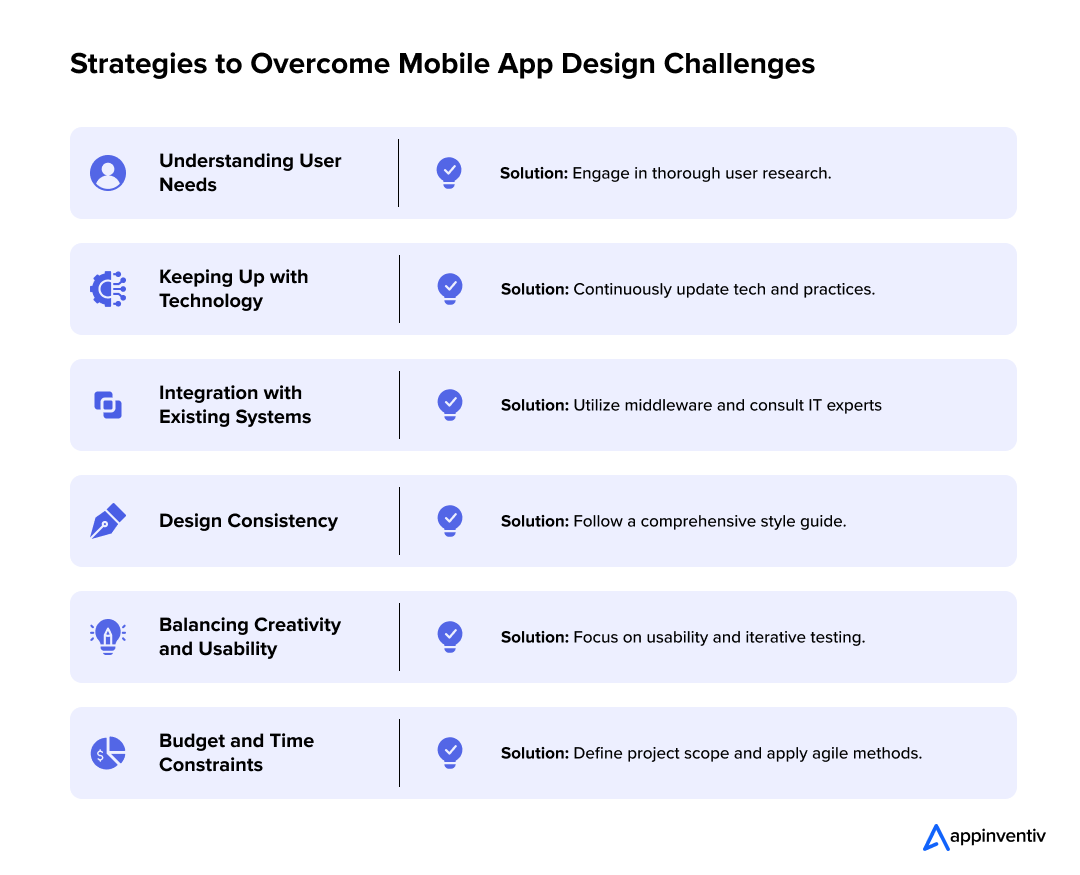 Understanding User Needs
Understanding User Needs
Properly understanding what the users need from the app can be difficult, which may result in features that don’t fully align with user expectations.
Solution: Conduct extensive user research through surveys, interviews, and focus groups to gather insights into user needs and preferences before beginning the design process.
Keeping Up with Technology
Technology evolves rapidly, and keeping the app compatible with the latest technological advancements can be challenging.
Solution: Regularly update the technology stack and design practices to stay current with the latest trends and software updates in the market.
Integration with Existing Systems
Ensuring the new app works seamlessly with existing business systems can be technically complex and time-consuming.
Solution: Use middleware and develop APIs that facilitate smooth integration. Consult with IT specialists to ensure compatibility and efficient data flow.
Design Consistency
Maintaining a consistent design across all screens and features can be challenging, especially when dealing with complex functionalities.
Solution: Develop and adhere to a detailed style guide that outlines design standards, color schemes, fonts, and other UI elements to maintain consistency.
Balancing Creativity and Usability
Striking the right balance between an aesthetically pleasing design and a functional user interface can be difficult, often leading to usability issues.
Solution: Prioritize usability in the design process by following best UX practices and conducting iterative user testing to refine the interface based on real user feedback.
Budget and Time Constraints
Staying within budget and on schedule can be challenging, especially when unexpected design changes are needed.
Solution: Establish a clear project scope and use agile development methodologies to manage changes efficiently and keep the project on track without escalating costs.
Future of Mobile App Design: What to Expect?
The future of mobile app design is all set for dynamic changes driven by technological advancements and evolving user expectations. Understanding upcoming trends is crucial as businesses look to stay competitive and relevant.
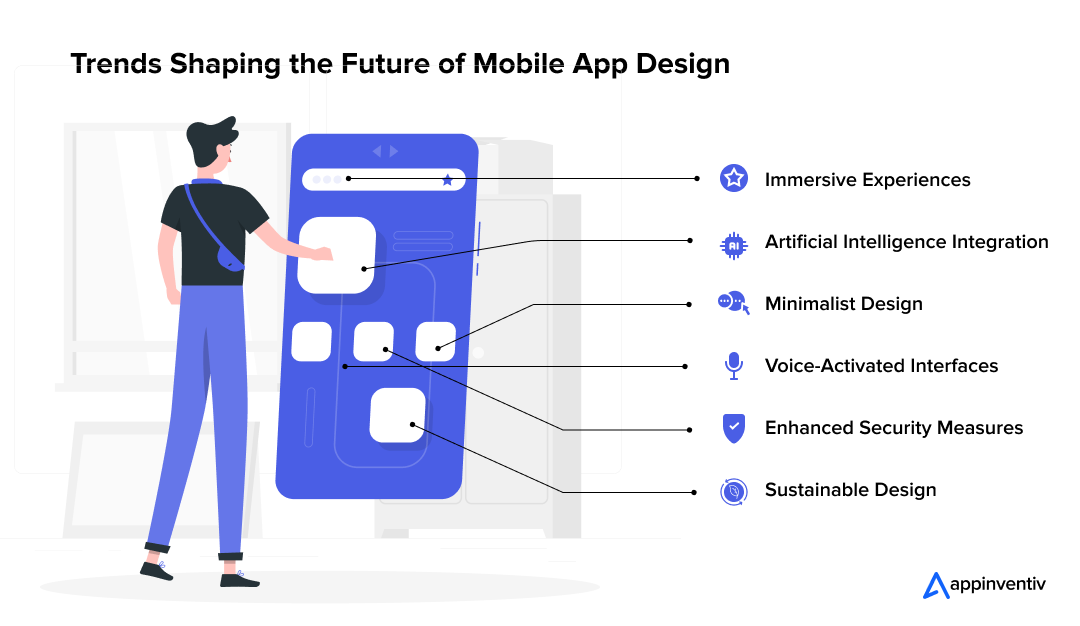
Immersive Experiences
Integrating augmented reality (AR) and virtual reality (VR) into mobile apps is becoming more prevalent. These technologies offer users immersive experiences that can transform standard app interfaces into interactive and engaging environments. For businesses, this means an opportunity to create highly engaging virtual try-on apps, interactive learning environments, and more, enhancing user engagement and satisfaction.
Artificial Intelligence Integration
Artificial Intelligence continues to refine how apps adapt to user behaviors and preferences. Predictive analytics, personalized content, and automated customer service are just a few areas where AI can elevate the user experience. Apps will become more intuitive, predicting user actions and providing tailored suggestions, making interactions quicker and more effective.
Minimalist Design
Simplicity in design remains a key trend, emphasizing minimalism and decluttering interfaces. This approach focuses on essential features with clean, straightforward designs that enhance usability and reduce user overwhelm. For businesses, this means prioritizing core functionalities and removing unnecessary elements, which can lead to faster load times and improved user retention.
Voice-Activated Interfaces
As voice recognition technology becomes more accurate, voice-activated interfaces are expected to rise. These interfaces allow for hands-free operation and accessibility, providing a seamless way for users to interact with apps. Businesses can enhance accessibility and user convenience by integrating voice commands, especially in apps focused on multitasking or accessibility.
Enhanced Security Measures
With increasing data privacy and security concerns, robust security features are becoming crucial for mobile app design. Features like biometric authentication, end-to-end encryption, and secure cloud integrations are becoming standard. For businesses, investing in advanced security measures protects users and builds trust and compliance with global data protection regulations.
Sustainable Design
There’s a growing emphasis on sustainability in app design, focusing on creating apps that use less battery and data and are optimized for longer life spans. This involves efficient coding, greener hosting solutions, and designs that promote less energy consumption. For businesses, adopting sustainable practices can appeal to environmentally conscious users and contribute to broader corporate social responsibility goals.
How to Pick the Right Design Partner?
Now that you have understood everything related to how much does it cost to design an app, it’s time to partner with a firm that can put your app on the trajectory. Here are four essential tips to help you find the best design partner for your business needs:
Review Their Portfolio
Take a close look at the design partner’s past projects to evaluate their aesthetic style and technical expertise. A strong portfolio should not only be visually attractive but also diverse, showcasing a wide range of projects across various industries. This diversity demonstrates the partner’s ability to adapt and deliver quality work across different contexts.
Check Client Testimonials and References
Insights from previous clients can provide valuable information about the design partner’s reliability, responsiveness, and the overall quality of work. Look for testimonials that highlight the partner’s ability to meet deadlines and achieve client satisfaction, which are crucial factors for a successful partnership.
Evaluate Their Technical Expertise
Your design partner must be proficient in the latest design tools and technologies. They should also understand best practices in user experience (UX) and be skilled in optimizing designs for various devices and platforms, ensuring a seamless user experience.
Assess Their Communication Skills
Good communication is essential for the success of any project. Your design partner should be able to clearly express their ideas, respond to feedback effectively, and understand your project goals. This will facilitate a smoother workflow and ensure the final product meets your expectations.
As a leading product design services firm, we are your ideal partner for developing a mobile app design that stands out and is effective and user-friendly. With our extensive expertise and a track record of helping major clients revamp their digital presence worldwide, we are equipped to bring your vision to life.
Our team has successfully integrated the latest technologies and innovative design strategies to create visually appealing and functional solutions tailored to each client’s unique needs.
Along with creating a visually appealing interface, we ensure your app reflects your brand identity. Being a dedicated mobile app development services provider, we work closely with your team to understand what your brand stands for and integrate your brand’s style and values into the app’s design. This way, your mobile app works well and feels like a part of your brand, helping strengthen customer loyalty and providing a familiar experience for your users.
For instance, we recently collaborated with Adidas, the largest sports merchandise brand, helping it revamp its digital presence. Our partnership resulted in a mobile app that helped the brand gain over 2 million downloads and 500k new users.
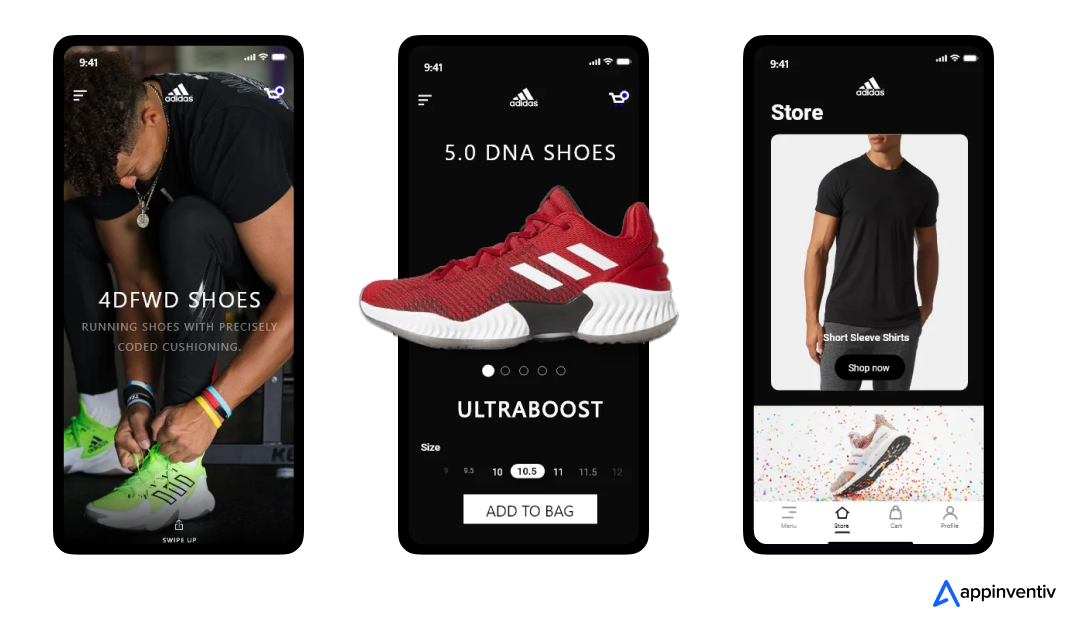
Similarly, we also helped the global franchise Domino’s with a UI/UX revamp, leading to the brand successfully witnessing increased conversion rates by 23%.
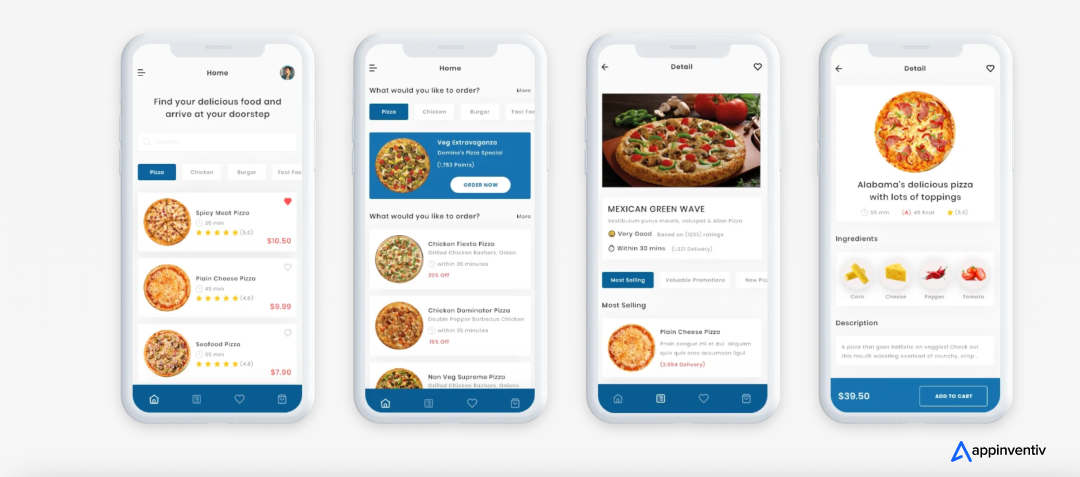
Contact us to see how we can transform your app idea into a successful reality, exceeding your expectations and enhancing your brand’s digital footprint.
FAQs
Q. How long does it take to design a mobile app?
A. The time it takes to design a mobile app can vary significantly based on its complexity, the number of features required, and the level of detail needed in the design. Generally, a simple app with basic functionality might take a few weeks to a few months to design. More complex apps, especially those requiring custom user interfaces or intricate animations, can take several months.
Q. How much does it cost to design an app?
A. The cost of designing a mobile app can vary significantly depending on various factors, including the design’s complexity, the designers’ experience level, and the design team’s expertise. Typically, you can expect to pay anywhere from $3,000 to $30,000 for app design. This range accommodates everything from simple app designs to more elaborate, feature-rich ones.
Q. How much does it cost to redesign an app?
A. The cost of redesigning an app can also vary widely but generally is a bit less than building an app from scratch unless major stru
ctural changes are needed. Redesign costs might range from $2,000 to $15,000. The total cost depends on the extent of the changes, the original app’s architecture, and whether the redesign includes significant updates to functionality or just cosmetic changes. This process often involves reevaluating the existing user feedback to pinpoint areas of improvement, which can help enhance user engagement and satisfaction without a full re-development.


- In just 2 mins you will get a response
- Your idea is 100% protected by our Non Disclosure Agreement.
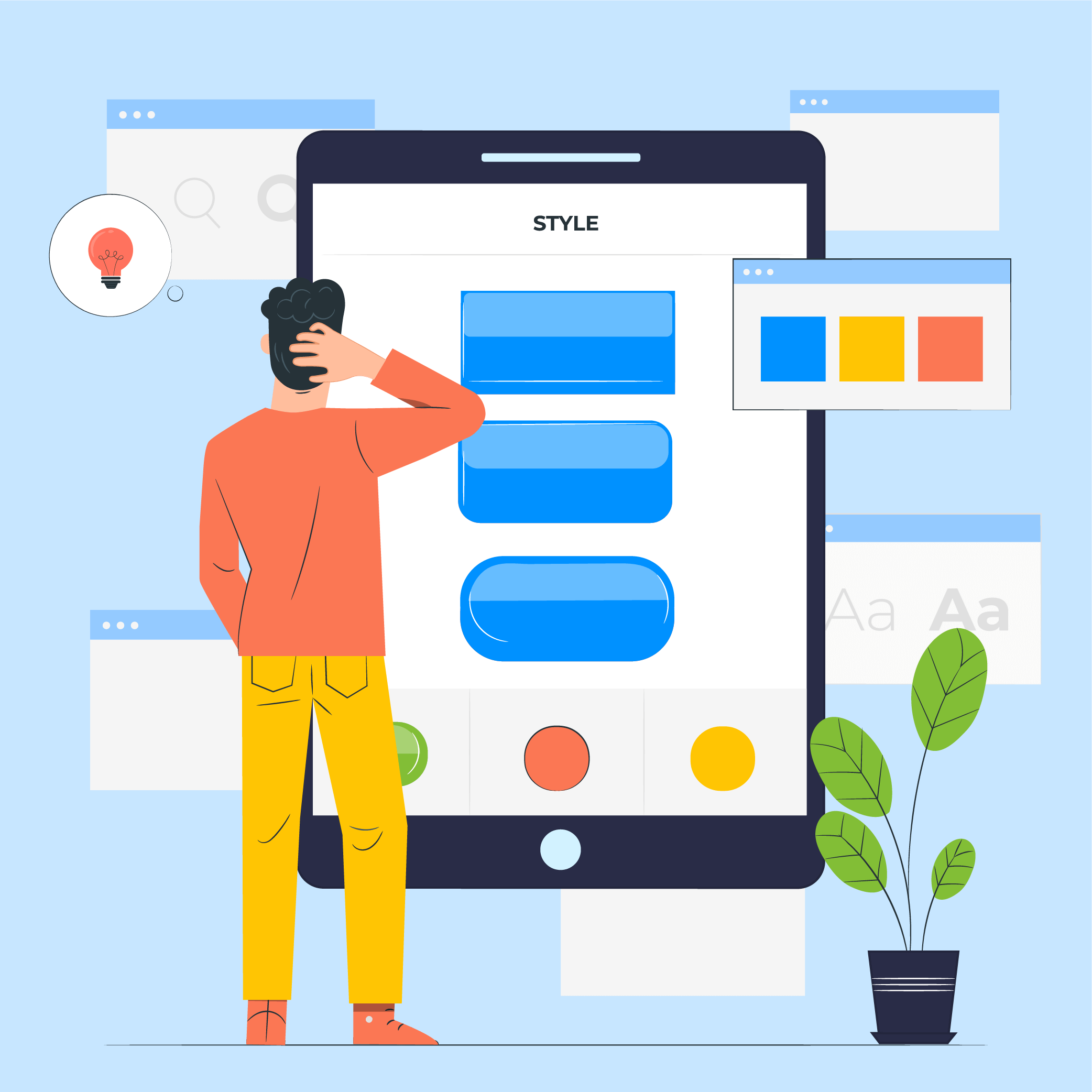
11 Principles of UX Design From A Startup Perspective
When we hear the word design, we think of creativity or some creative role, in which an individual crafts and designs something beautiful. But, there is a thing with UX design that makes us understand that only aesthetically good designs won’t make for a usable interface. A good user designer makes great user research. When…
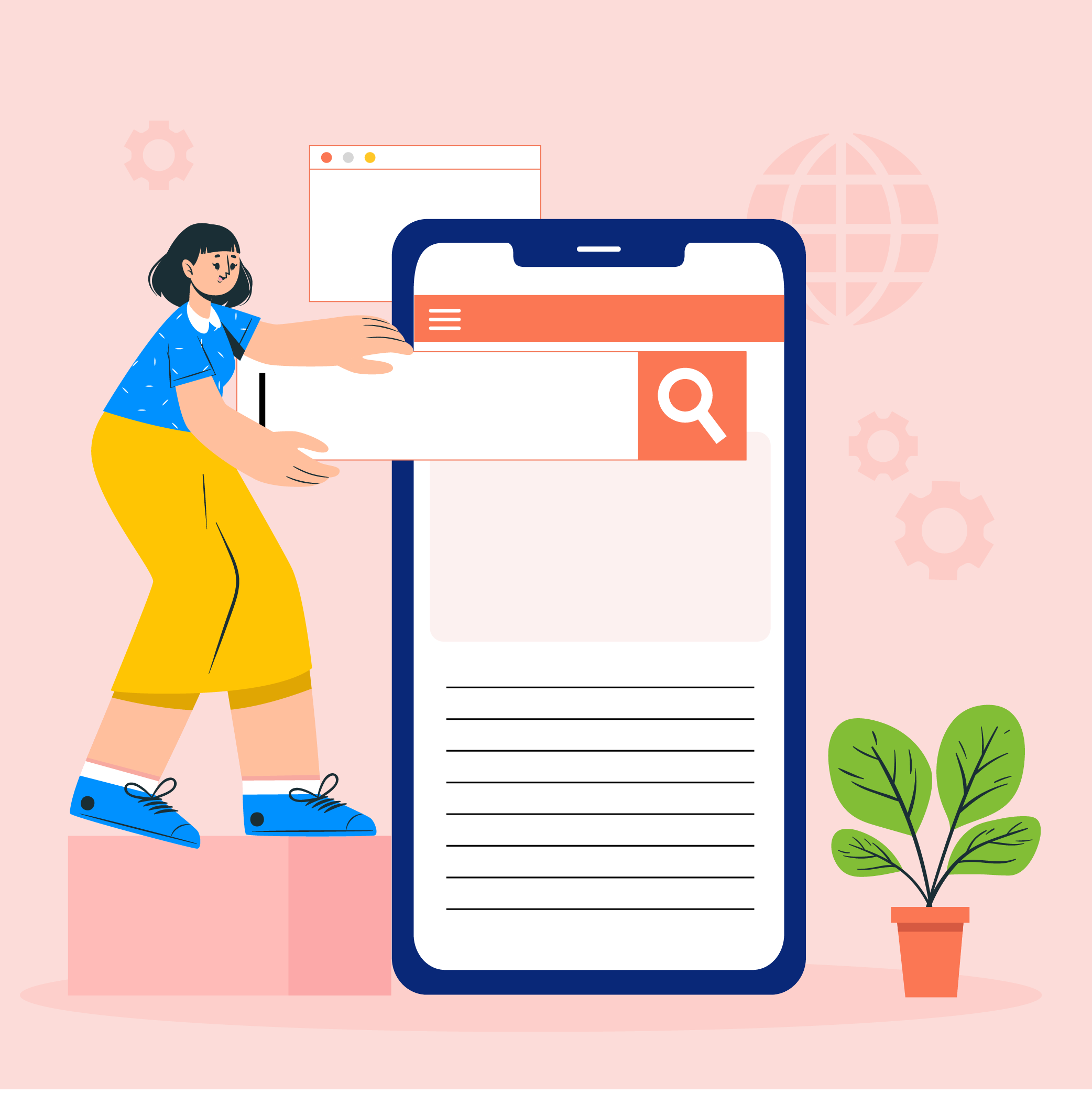
Intuitive Search Specs that Separate the Best from the Rest
Sometimes you hear people utter the phrase “I had an intuition” at which point you may wonder whether he/she has the ability to view the future. But that isn’t the case. Intuition is the feeling people derive based on instinct and this instinct isn’t based on conscious reasoning. This subliminal, cerebral concept holds immense significance…
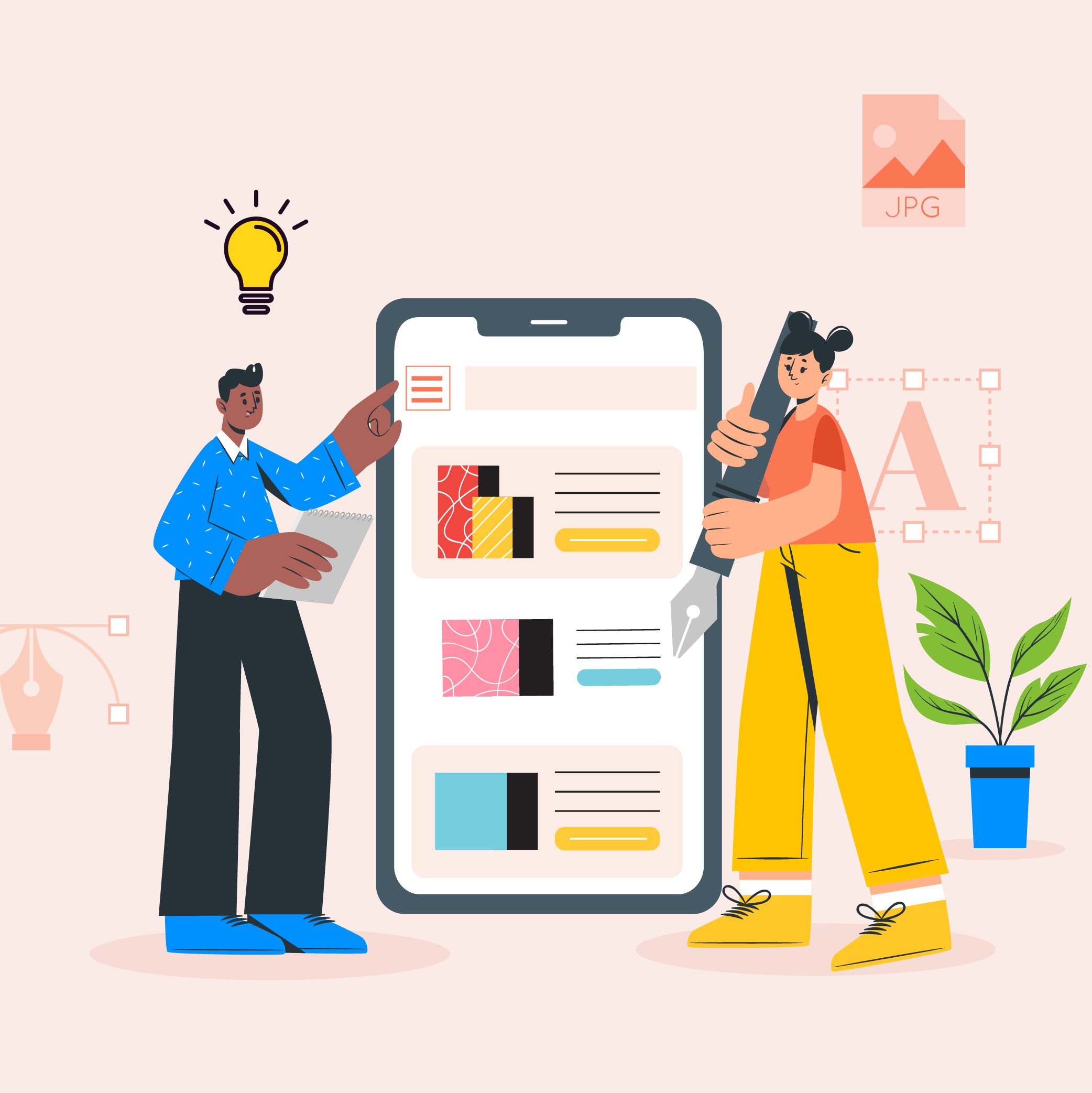
15 Steps to Mobile App Redesign for Market Domination
App redesign is no joke. If you run a mobile-powered business then you are virtually on life-support while indulging in a UI UX overhaul. And if you do not realize that already, then there is all the more need for someone to point you in the right direction. We assume you want a word by…
